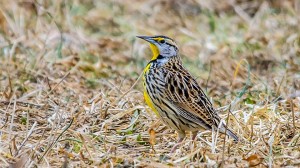From the Cornell Ornithology Laboratory, Ithaca, NY, December 10, 2018
Under future climate scenarios, changing winds may make it harder for North American birds to migrate south in the autumn but easier for them to come north in the spring.
Researchers from the Cornell Lab of Ornithology came to this conclusion using data from 143 weather radar stations to estimate the altitude, density and direction birds took during spring and autumn migrations over several years. They also extracted wind data from 28 climate-change projections in the most recent report from the Intergovernmental Panel on Climate Change. Their findings were published December 9th in Global Change Biology.
“We combined these data to estimate how wind assistance is expected to change during this century under global climate change,” said lead author Frank La Sorte, a Cornell Lab of Ornithology scientist. “This matters for migratory birds because they use more energy flying into headwinds. But they get a nice boost from tailwinds so they can conserve energy during flight.”
La Sorte and co-authors predict winds from the south will become stronger by the end of the century during spring and fall migration periods. Winds from the west may be stronger during spring migration and slightly weaker during the fall. Westerly winds are much more variable overall and harder to predict because they are tied to erratic fluctuations in the high altitude jet stream. Wind changes will be most pronounced in the central and eastern portions of the continent.
With an assist from stronger tailwinds during spring migration, birds would likely arrive at their northern breeding grounds in better condition and with better odds of survival. Their fall migration flights into stronger headwinds would drain more energy. If headwinds are too strong, birds may choose not to fly at all on a particular night, throwing off the timing of their migrations.
“The thing to remember about these projected wind changes is that they will not occur in isolation,” La Sorte said. “There will be other global change factors for birds to contend with, including changes in temperatures, rainfall and land cover.”
Some birds may be able to adapt because the expected wind changes are likely to happen gradually. Studies also show migratory birds already adjust their migration strategy under current conditions, altering their headings to compensate for winds that push them from their intended flight path.
“The bottom line is that some climate change effects could be negative for migratory birds, and some might even be positive, as least for a while,” said La Sorte. “There’s an awful lot of uncertainty because both climate and migration are complex systems that can intersect in many different ways.”
Support for this study came from the Wolf Creek Charitable Foundation, Amazon Web Services and the National Science Foundation.
NOTE: Climate Change is primarily due to the accumulation of greenhouse gases in the atmosphere of the Earth. Carbon dioxide comes primarily from the burning of coal and natural gas in power plants to make electricity. Automobiles burn gasoline from oil which also makes carbon dioxide. Methane is also a very potent greenhouse gas, coming from natural gas. DGN
##############################
Mountain of Evidence Confirms: Climate Change Is Really, Really Bad for Human Health and Well-Being
Article by Laura Geggel, Live Science, December 14, 2018
It’s now beyond official: Greenhouse gases, such as carbon dioxide, pose a danger to public health and welfare, according to an exhaustive review that looked at 275 scientific studies published over the past nine years.
Researchers did the report to investigate whether the Environmental Protection Agency’s (EPA) 2009 Endangerment Finding, which found that greenhouse gases pose a risk to human health, still held up. The new study showed that there is now even more evidence that greenhouse gases are harming human health and welfare. The investigation also found an additional four areas, not listed in the original report, in which greenhouse gases threaten people.


{ 1 comment… read it below or add one }
Progress and problems as UN climate change talks end with a deal | Environment | The Guardian, December 16, 2018
The UN climate change talks ended late on Saturday night in Poland with a deal agreed on how to put the 2015 Paris agreement into action, but with other contentious problems left to be resolved next year.
Countries thrashed out the complex details of how to account for and record their greenhouse gas emissions, which will form the basis of a “rulebook” on putting the Paris goals into action. But difficult questions such as how to scale up existing commitments on cutting emissions, in line with stark scientific advice, and how to provide finance for poor countries to do the same, were put off for future years.
https://www.theguardian.com/environment/2018/dec/15/progress-and-problems-as-un-climate-change-talks-end-with-a-deal